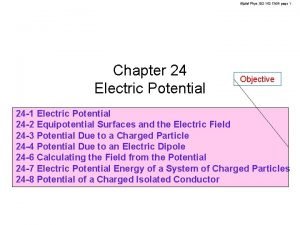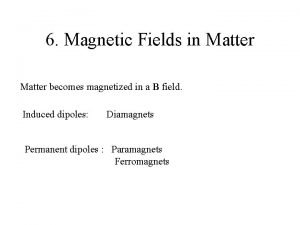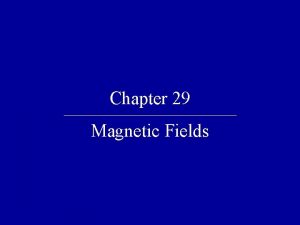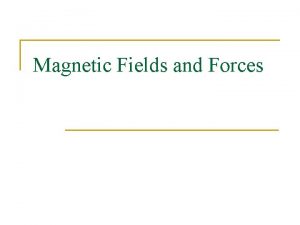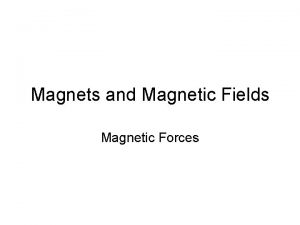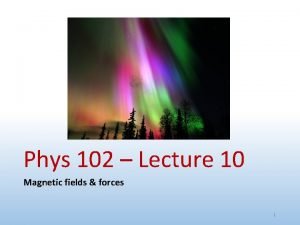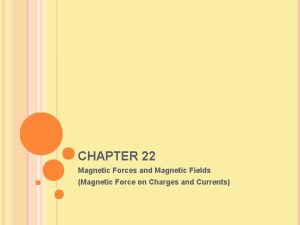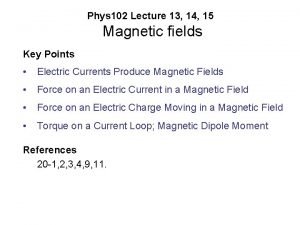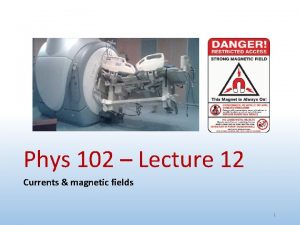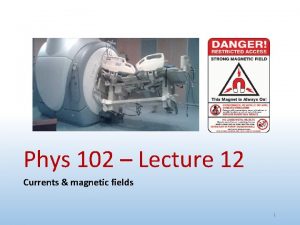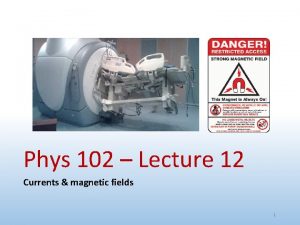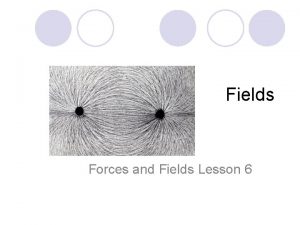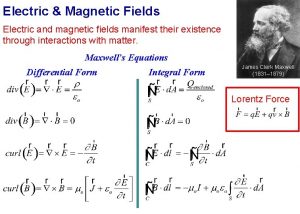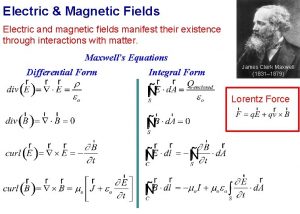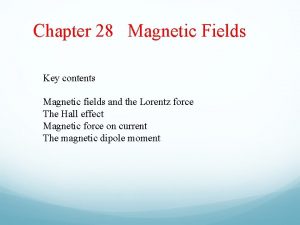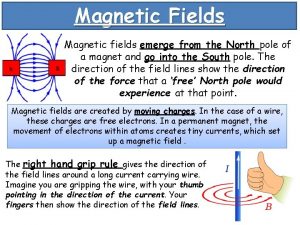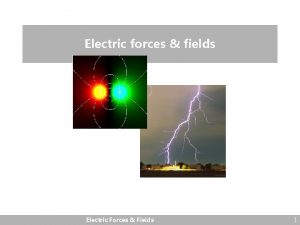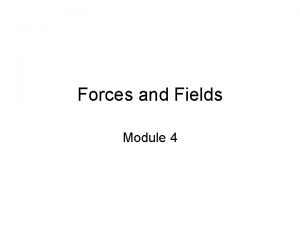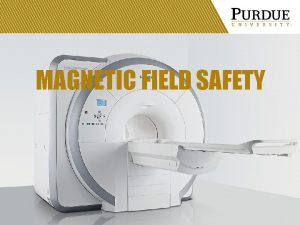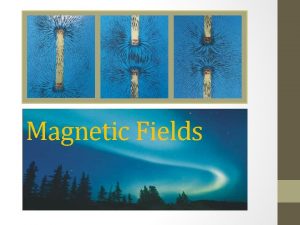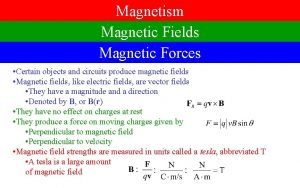Phys 102 Lecture 10 Magnetic fields forces 1






















- Slides: 22

Phys 102 – Lecture 10 Magnetic fields & forces 1

Today we will. . . • Learn about the magnetism Magnetic field B Magnetic force F on moving charge • Apply these concepts! Charged particle motion in a magnetic field Mass spectrometry Earth’s magnetic field & northern/southern lights Phys. 102, Lecture 10, Slide 2

Electricity vs. magnetism • Magnetism • Electricity Positive & negative charge Opposite charges attract, like charges repel – + + N & S poles N & S always together as dipole (NO “magnetic charge”) Opposite poles attract, like poles repel N S N + N S S N – – S N N S DEMO Phys. 102, Lecture 10, Slide 3 S

Electricity vs. magnetism • Electric field • Magnetic field Vector at location in space Points from positive & negative Q Units: N/C = V/m + Vector at location in space Points from N to S pole Units: T (“Tesla”) – Electric dipole E field DEMO Magnetic dipole B field Phys. 102, Lecture 10, Slide 4

Sources of magnetic fields There is no magnetic charge, so where do magnetic fields come from? + – Moving electric charge (current) Lecture 12 – Geodynamo Intrinsic magnetic dipole (“spin”) Lecture 25 Phys. 102, Lecture 10, Slide 5

Magnetic force Magnetic field B exerts a force on a moving charge q: e M Angle between v and B d tu i gn a Magnetic field strength Speed of charge q re Di io ct n “Right-hand rule” (RHR) θ DEMO + q Thumb along Fingers along on + q is out of palm on – q is into palm F is to both v and B Phys. 102, Lecture 10, Slide 6

ACT: right hand rule practice A + charge moving to the right in a uniform B field experiences a force F up. Which way does the B field point? F q + v A. B. C. D. Up Down Into the page Out of the page Phys. 102, Lecture 10, Slide 7

ACT: right hand rule practice A – charge moving out of the page in a uniform B field to the left experiences a force F in which direction? B – q v A. B. C. D. Up Down Into the page Out of the page DEMO Phys. 102, Lecture 10, Slide 8

ACT: Moving charges The three charges below have equal charge and speed, but are traveling in different directions in a uniform magnetic field. θ 3 θ 2 1 θ Which particle experiences the greatest magnetic force? A. 1 B. 2 C. 3 D. All same The force on charge 3 is in the same direction as the force on 1 A. True B. False Phys. 102, Lecture 10, Slide 9

Checkpoint 1. 1 Each chamber has a unique magnetic field. A positively charged particle enters chamber 1 with velocity 75 m/s up, and follows the dashed trajectory. v 1 + 2 v = 75 m/s q = +25 m. C What is the direction of the force on the particle just as it enters region 1? A. up B. down C. left D. right Phys. 102, Lecture 10, Slide 10

ACT: Checkpoint 1. 2 Each chamber has a unique magnetic field. A positively charged particle enters chamber 1 with velocity 75 m/s up, and follows the dashed trajectory. v 1 + 2 v = 75 m/s q = +25 m. C What is the direction of the magnetic field in region 1? A. up B. down C. into page D. out of page Phys. 102, Lecture 10, Slide 11

Checkpoint 1. 4 Each chamber has a unique magnetic field. A positively charged particle enters chamber 1 with velocity 75 m/s up, and follows the dashed trajectory. F + v 2 1 v = 75 m/s q = +25 m. C What is the direction of the magnetic field in region 2? A. up B. down C. into page D. out of page Phys. 102, Lecture 10, Slide 12

ACT: Checkpoint 1. 5 Each chamber has a unique magnetic field. A positively charged particle enters chamber 1 with velocity 75 m/s up, and follows the dashed trajectory. 1 + 2 v = 75 m/s q = +25 m. C How do the magnitudes of the B fields in region 1 and 2 compare? A. |B 1| > |B 2| B. |B 1| = |B 2| C. |B 1| < |B 2| Phys. 102, Lecture 10, Slide 13

Motion in uniform B field Charged particle moves along x to B field Particle moves in a circle + F v R Principle of mass spectrometer B field does no work (since F d) Kinetic energy is constant Speed is constant y B x DEMO Phys. 102, Lecture 10, Slide 14

Mass spectrometer Mass spectrometry uses a B field to analyze chemical compounds Compound is vaporized into fragments & ionized, accelerated with a E field into a B field Fragments separate according to mass to charge ratio (m/q) Phys. 102, Lecture 10, Slide 15

Calculation: Mass spectrometer A mass spectrometer is used to separate different isotopes of carbon. Carbon ions are accelerated to a speed v = 105 m/s; assume all have charge +1 e = 1. 6× 10– 19 C. B = 0. 2 T 13 C+ v = 105 m/s Find which C isotope travels along the green dotted path to the detector. FA 13 EX 2 R = 6. 8 cm 13 C+ Which way does the B field point? Phys. 102, Lecture 10, Slide 16

ACT: Mass spectrometer I The mass spectrometer isolates three C isotopes a, b, c. They move at a speed v = 105 m/s entering the B field and follow the dashed paths. Magnet C ion beam v = 105 m/s a R c b Detector How do the speeds of the different isotopes a, b, c leaving the B field compare? A. va > vb > vc B. va = vb = vc C. va < vb < vc Phys. 102, Lecture 10, Slide 17

ACT: Mass spectrometer II The mass spectrometer isolates three C isotopes a, b, c. They move at a speed v = 105 m/s entering the B field and follow the dashed paths. Magnet C ion beam v = 105 m/s a R c b Detector How do the masses of the different isotopes a, b, c compare? A. ma > mb > mc B. ma = mb = mc C. ma < mb < mc Phys. 102, Lecture 10, Slide 18

3 -D motion in uniform B field What if particle v has a component along B? Charged particle moves in x-z plane, B field along z B + z + + v F B x F=0 Component || to B remains constant x F = q. Bv Component to B rotates in a circle Charge moves in a helical trajectory B = y v|| z x v v v|| + y ⊥ Phys. 102, Lecture 10, Slide 19

Aurora borealis & australis Earth’s B field protects against stream of ions from sun (“solar wind”) z x B y Aurora australis “Southern lights” B field directs ions to atmosphere in north and south hemispheres. Ions collide with particles in atmosphere and emit light: “aurora” Phys. 102, Lecture 10, Slide 20

Summary of today’s lecture Electric vs. magnetic forces Force: Source: Act on: Magnitude: Direction: Work: Electric Charge FE = q E || to E WE = q. Ed cos(θ) Magnetic Moving charge FB = q v B sin(θ) to v, B WB = 0 Phys. 102, Lecture 10, Slide 21

B v v F B F v F B Phys. 102, Lecture 10, Slide 22
 Learning: module 26: magnetic forces and fields
Learning: module 26: magnetic forces and fields Aljalal phys 102
Aljalal phys 102 Physics 102 uiuc
Physics 102 uiuc Aljalal phys 102
Aljalal phys 102 Phys 241 purdue
Phys 241 purdue Red fields to green fields
Red fields to green fields Scrap heap magnet diagram
Scrap heap magnet diagram Visualizing magnetic field
Visualizing magnetic field Magnetic field in matter
Magnetic field in matter Magnetic force quiz
Magnetic force quiz Electric currents and magnetic fields
Electric currents and magnetic fields Electric forces and fields concept review
Electric forces and fields concept review Chapter 16: electric forces and fields answers
Chapter 16: electric forces and fields answers Magnetic moment and magnetic field relation
Magnetic moment and magnetic field relation Magnetic field strength formula
Magnetic field strength formula Magnetic force particle
Magnetic force particle Magnetic permeability of materials
Magnetic permeability of materials 01:640:244 lecture notes - lecture 15: plat, idah, farad
01:640:244 lecture notes - lecture 15: plat, idah, farad Facts about magnetism
Facts about magnetism Balanced forces and unbalanced forces venn diagram
Balanced forces and unbalanced forces venn diagram Similarities of intermolecular and intramolecular forces
Similarities of intermolecular and intramolecular forces What are constructive and destructive forces
What are constructive and destructive forces The resultant of two unlike parallel forces
The resultant of two unlike parallel forces



